Dr. Lalitha Subramanian
About the Author

Aksharam
For a polynomial function $y=f(x)$ and a real number $k$, the following statements are equivalent:
While finding out the real zeros of a polynomial function, the following properties need to be understood and remembered:
Division Algorithm for Polynomials: Let $f(x)$ and $d(x)$ be two polynomials with degree of $d(x)$ less than or equal to the degree of $f(x)$. When $f(x)$ is divided by $d(x)$, we get a unique quotient $q(x)$ and a unique remainder $r(x)$, such that $f(x)=d(x) \dot q(x) + r(x)$, where the remainder $r(x)$ is either zero or of a lesser degree than the degree of $d(x)$. This summary statement is sometimes written in fraction form as below: $$ \frac{f(x)}{d(x)} = q(x) + \frac{r(x)}{d(x)}$$. The polynomial $f(x)$ is called dividend and the polynomial $d(x)$ is called divisor.
The division of $f(x)$ by $d(x)$ is generally performed using long division method. In special cases where the divisor $d(x)$is a linear binomial, this division process can be simplified into a synthetic division method.
Write the summary statement in both polynomial and fractional form for the division problem $\frac{2x^4-x^3+2x^2+3} {2x^2+x+1}$.
Solution:Perform the long division as shown below:
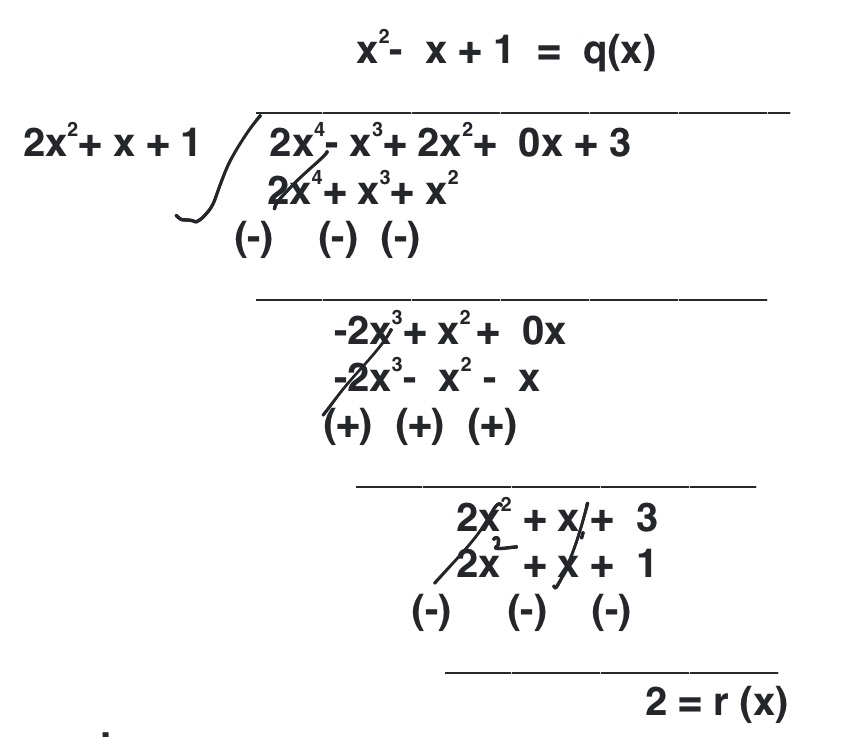
The summary statement in fractional form is: $\quad \frac{2x^4-x^3+2x^2+3}{2x^2+x+1} = x^2-x+1 + \frac{2}{2x^2+x+1}$
Remainder Theorem states that, if a polynomial $f(x)$ is divided by a linear binomial $x-k$, then the remainder is $f(k)$.
Verify the remainder theorem using long division when $2x^3-3x^2+5x-2$ is divided by $x+1$
Solution:Performing long division as below, we note that the remainder is $-12$.
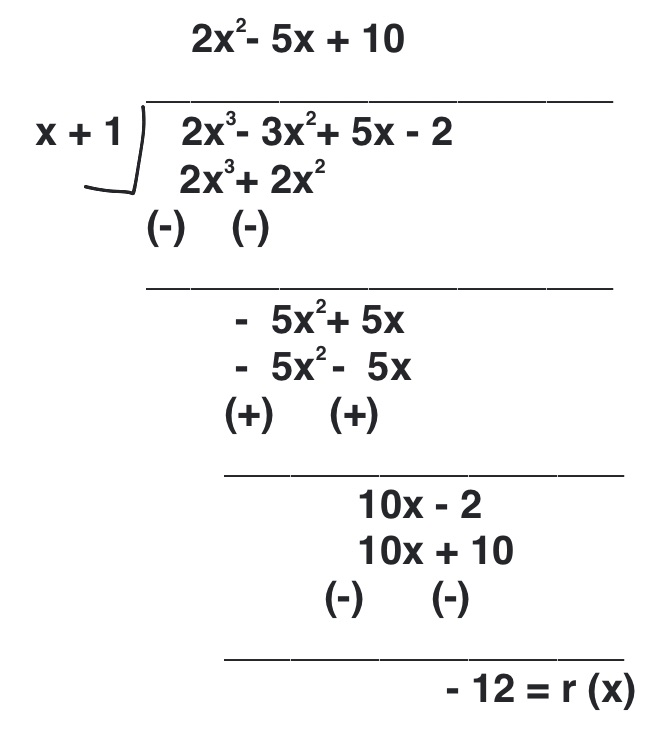
Using remainder theorem, first we set the divisor $x+1 = 0$, which gives $x = -1$. Then, we evaluate the value of the polynomial for $x=-1$:
\begin{eqnarray} f(-1) &=& 2(-1)^3-3(-1)^2+5(-1)-2\\ &=& -2-3-5-2\\ &=& -12\\ \end{eqnarray}.
Find the remainder when $f(x)=2x^4-x^3+4x^2-3x-1$ is divided by $x-2$
Solution:Setting the divisor $x-2 = 0$, we get $x=2$. Using remainder theorem, we have the remainder $r = f(2)$. Evaluating, we get: \begin{eqnarray} f(2) &=& 2(2)^4 - (2)^3 + 4(2)^2 - 3(2) - 1\\ &=& 32-8+16-6-1\\ &=& 33\\ \end{eqnarray}.
Factor Theorem says that, a polynomial $f(x)$ has a factor $x-k$ if and only if $f(k)=0$. This follows from the remainder theorem as a factor always divides the dividend evenly, resulting in zero remainder. This theorem gives us an easy way to check if a linear binomial $x-k$ is a factor of a polynomial $f(x)$.
Determine if $x+4$ is a factor of the polynomial $f(x)=3x^2+7x-20$
Solution:Applying the factor theorem, we find the remainder: \begin{eqnarray} f(-4) &=& 3(-4)^2+7(-4)-20\\ &=& 48-28-20\\ &=& 0\\ \end{eqnarray} So, $x+4$ is a factor of the given polynomial.
Determine if $x-2$ is a factor of the polynomial $f(x)=x^4-7x^3+3x^2-12$
Solution:Applying the factor theorem, we find the remainder: \begin{eqnarray} f(2) &=& (2)^4-7(2)^2+3(2)-12\\ &=& 16-28+6-12\\ &=& -18\\ \end{eqnarray} So, $x-2$ is a not factor of the given polynomial, as the remainder is not zero.
When the divisor is a linear binomial of the form $x-k$, a simpler way of dividing $f(x)$ by $x-k$ is using synthetic division. This method is done using the following steps:
Divide $x^4-2x^3-3x^2+4x$ by $x+1$ using synthetic division and give a summary statement of the division.
Solution: From the division shown below, the summary statement is $x^4-2x^3-3x^2+4 = (x+1)(x^3-3x^2+4)-4$
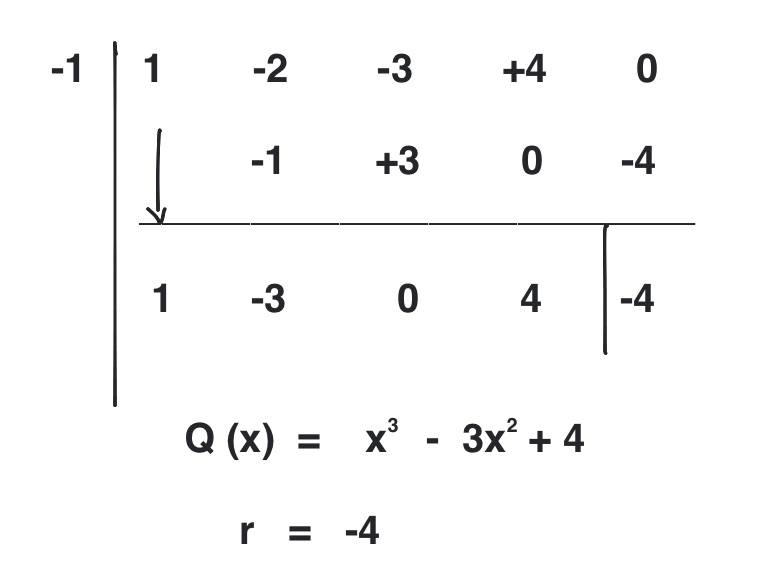
Divide $2x^4-4x^2+x+-6$ by $x-2$ using synthetic division and give a summary statement of the division as fraction.
Solution: From the division shown below, the summary statement is $\frac{2x^4-4x^2+x+-6}{x-2} = 2x^3+4x^2+4x+9 + \frac{12}{x-2}$
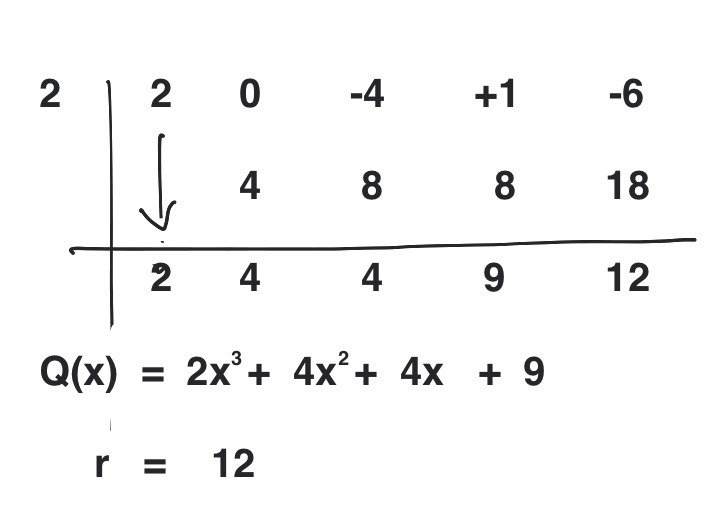
Rational Zeros Theorem states that, if $\frac{p}{q}$, where $p$ and $q$ are integers, is a rational zero of a polynomial $f(x)$, then the numerator $p$ is a factor of the constant term and the denominator $q$ is a factor of the leading coefficient of the polynomial. Thus, the rational zeros of the polynomial $2x^4-4x^3-x^2-x+4$ can be determined by considering all combinations of fractions that satisfies the above theorem. That is, the numerator of the zero is any of the factors of the constant term 4: $\quad \pm{1}\quad \pm{2}, \quad \pm{4}$, and the denominator is any of the factors of the leading coefficient 2: $\quad \pm{1}, \quad \pm{2}$. Of all the combinations of $p$ and $q$, we can determine which rational numbers are zeros of a polynomial using the factor theorem.
Find the real zeros of the polynomial $f(x)=2x^4-4x^3-x^2-3x2+4$
Solution: From the explanation given above possible zeros are: $\quad \pm\frac{4}{1}, \quad \pm\frac{2}{1}, \quad \pm \frac{1}{1}, \quad \frac{4}{2}, \quad\pm \frac{2}{2}, \quad \pm\frac{1}{2}$. Thus, possible zeros are $\quad \pm{4}, \quad \pm{2}, \quad \pm{}1, \quad \pm\frac{1}{2}$. Now, we need to find which of these are the zeros of the polynomial using factor theorem: \begin{eqnarray} f(4) &=& 2(4)^4-4(4)^3-(4)^2-(4)+4 &\neq& 0\\ f(-4) &=& 2(-4)^4-4(-4)^3-(-4)^2-(-4)+4 &\neq& 0\\ f(2) &=& 2(2)^4 - 4((2)^3-(2)^2-(2)+4 &\neq& 0\\ f(-2) &=& 2(-2)^4 - 4(-2)^3)-(-2)^2-(-2)+4 &\neq& 0\\ f(1) &=& 2(1)^4 -4(1)^3 - (1)^2 -(1)+4 &=& 0\\ f(-1) &=& 2(-1)^4-4(-1)^3-(-1)^2-(-1)+4 &\neq& 0\\ f\left(\frac{1}{2}\right) &=& 2\left(\frac{1}{2}\right)^4 --4\left(\frac{1}{2}\right)^3 -\left(\frac{1}{2}\right)^2 - \left(\frac{1}{2}\right) +4 &\neq& 0\\ f(-\left(\frac{1}{2}\right) &=& 2\left(-\frac{1}{2}\right)^4 - 4\left(-\frac{1}{2}\right)^3 - \left(-\frac{1}{2}\right)^2 - \left(\frac{1}{2}\right) +4 &\neq& 0\\ \end{eqnarray} We note that the polynomial has only one rational zero at $x=1$. This means that the graph of this polynomial intersects the $x$-axis at only one point $x=1$.
Find the rational zeros of the polynomial $f(x)=x^3-2x^2+1$
Solution: Rational zeros should by one of the numbers $\frac{\pm{1}}{\pm{1}}$. That is, either $1$ or $-1$. \begin{eqnarray} f(1) &=& (1)^3 - 2(1)^2 + 1 &=& 0\\ f(-1) &=& (-1)^3 - 2(-1)^2 + 1 &\neq& 0\\ \end{eqnarray}. So, this polynomial has only one rational zero at $x=1$.
To find all the real zeros of a polynomial, we use the following steps:
Find the real zeros of the polynomial $f(x) = x^4-x^3-7x^2+5x+10$
Solution: Using rational zeros theorem, we note that the rational zeros should be one of $\{ \pm{1}, \quad, \pm{2}, \quad \pm{5}, \pm{10}\}$. Using factor theorem, we find that $f(-1) = 0$. So, we use synthetic division to find quotient, which would be of degree 3. Repeating the same steps results in a quotient of degree 2:$ x^2-5$. This quadratic polynomial can be solved by setting it to zero, to get all real zeros of the polynomial.
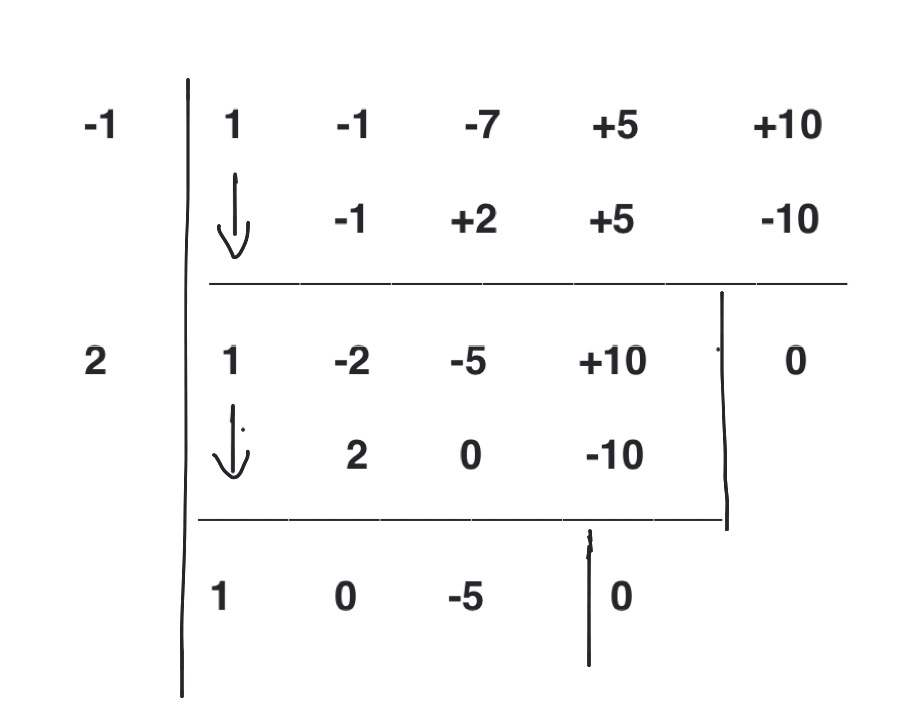
So,real zeros of the polynomial are $\{-1, \quad 2, \quad \sqrt{5}, \quad-\sqrt{5}\}$.
We note that if an irrational number is a zero of a polynomial with real coefficients, its conjugate also will be a zero. We know that the set of real numbers is a subset of the set of complex numbers. In that light, we can say that the complex number system is the super set. So, a complex number $z=a +bi$ is real if $b = 0$ and non-real if $b \neq 0$. Fundamental Theorem of Algebra states that every polynomial function of degree $n$ with real coefficients has exactly $n$ zeros, real or non-real. some of these may be repeated. If a complex number $z=a+bi$ is a zero of a polynomial function with real coefficients, then its complex conjugate $\bar{z}=a=bi$ is also a zero of that polynomial. Linear Factorization Theorem states that, if $f(x)$ is a polynomial with real coefficients of degree $n >0$, then $f(x)$ has exactly $n$ linear factors and it can be written in factor form as $f(x) = a(x-z_{1})(x-z_{2})\cdots (x-z_{n})$, where $a$ is the leading coefficient of the polynomial. Setting each factor to zero gives the zeros of the polynomial. Some of these zeros could be real, and some could be complex. But, if the polynomial has real coefficients, then the irrational or complex zeros always occur in pairs. That is, $a + b\sqrt{c}$ is a zero, then $a - b\sqrt{c}$ will also be zero. Similarly, if $a + bi$ is a zero, then, $a - bi$ is also a zero.
Find a polynomial of least degree with zeros $\{1,\quad 3, \quad -2\}$
Solution: Using the linear factorization theorem and choosing $a=1$, we have: \begin{eqnarray} f(x) &=& 1(x-1)(x-3)(x+2)\\ &=& (x^2-4x+3)(x+2)\\ &=& x^3-2x^2-5x+6\\ \end{eqnarray}
Find a polynomial with zeros $\{ -1,\quad 3i, \quad 2\}$
Solution: Here, as $3i$ is a zero, its complex conjugate $-3i$ is also a zero. So, the polynomial is of 4th degree. Using the linear factorization theorem and choosing $a=1$, we have: \begin{eqnarray} f(x) &=& 1(x+1)(x-3i)(x+3i)(x-2)\\ &=& (x+1)(x^2+9)(x-2)\\ &=& x^4+7x^2-9x-18\\ \end{eqnarray}
Find a polynomial with zeros $\{-4,\quad 2+3i\}$
Solution: Here, as $2+3i$ is a zero, its complex conjugate $2-3i$ is also a zero. So, the polynomial is of 3rd degree. Using the linear factorization theorem and choosing $a=1$, we have: \begin{eqnarray} f(x) &=& 1(x+4)\left(x-(2+3i)\right)\left(x-(2-3i)\right)\\ &=& (x+4)\left((x-2)-3i\right)\left((x-2)+3i\right)\\ &=& (x+4)\left((x-2)^2+9\right)\\ &=& ((x+4)(x^2-4x+4+9)\\ &=& (x+4)(x^2-4x+13)\\ &=& x^3 -3x+52\\ \end{eqnarray}
Find a polynomial with miinimum degree in standard form and with real coefficients whose zeros are $1$ with multiplicity $1$ and $1+3i$ with mutiplicity $2$
Solution: Here, $1+3i$ is a zero of multiplicity $2$. So, using the linear factorization theorem and choosing $a=1$, we have: \begin{eqnarray} f(x) &=& 1(x-1)\left(x-(1+3i)\right)^2\left(x-(1-3i)\right)^2\\ &=& (x-1)\left((x-1)^2+9\right)^2\\ &=& x^5-5x^4+28x^3-64x^2+140x-100\\ \end{eqnarray}
$f(x) = (x-1)(4x^2-2x)-3$
$\frac{x^4 -2x^3 + 3x^2 -3x+4}{x+2} = (x^3-4x^2+11x-25) + \frac{54}{x+2}$
$f(x) = (5x^2+8x-5)(x^2-2x-3)+(11x-16)$
$\frac{3x^4+2x^3-4x^2+9x-2}{x+3} = (3x^3-7x^2+17x-42) + \frac{124}{x+3}$
$-9$.
$-48$
No.
No.
$(x+1,6),\quad (x-0.6), \quad (x-2)$
$f(x)=2x^4-5x^3-12x^2-7x$
$f(x)=2x^3+2x^2-8x-8$
$f(x)=x^4-2x^3+x^2-18x-72$.
$f(x)=x^4-2x^3+12x^2-2x+11$
$f(x) = -2x^5+18x^4-70x^3+154x^2-200x+100$
$f(x)=-5x^3+21x^2-75x+45$
$\{ \pm{6},\pm{3}, \pm{2}, \pm{1}, \pm{\frac{1}{2}}, \pm{\frac{3}{2}} \}$
NO.
$\{-1, 2 \sqrt{5}, -\sqrt{5}\}$
$\{-2, 1, 4, i, -i\}$
$f(x) = (x-1)(x-4)(x+2)(x^2+1)$
$x^3+x^2+9x+9$
Zeros are $\{-3, -1, 4\}$, $-1$ has multiplicity 3. $f(x) = (x+1)^3(x+3)(x-4)$
$\{\frac{1}{2}, -2, 3\}$.
$f(x) = (x-2-\sqrt{3})(x-2+\sqrt{3})$
$f(x) = (x-\sqrt{7})(x+\sqrt{7})(x^2+x+1)$